Abstract
Purpose
The purpose of this study was to investigate the effect of different thread designs on the marginal bone stresses around dental implant.
Materials and methods
Standard ITI implant(ITI Dental Implant System; Straumann AG, Waldenburg, Switzerland), 4.1 mm in diameter and 10 mm in length, was selected as control. Test implants of four different thread patterns were created based on control implant, i.e. maintaining all geometrical design of control implant except thread pattern. Four thread designs used in test implants include (1) small V-shape screw (model A), (2) large V-shape screw (model B), (3) buttress screw (model C), and (4) trapezoid screw (model D). Surface area for unit length of implant was 14.4 mm2 (control), 21.7 (small V-shape screw), 20.6 (large V-shape screw), 17.0 (buttress screw) and 28.7 mm2 (trapezoid screw). Finite element models of implant/bone complex were created using an axisymmetric scheme with the use of NISA II/DISPLAY III (Engineering Mechanics Research Corporation, Troy, MI, USA). A load of 100 N applied to the central node on the crown top either in parallel direction or at 30 degree to the implant axis (in order to apply non-axial load to the implant NKTP type 34 element was employed). Quantification and comparison of the peak stress in the marginal bone of each implant model was made using a series of regression analyses based on the stress data calculated at the 5 reference points which were set at 0.2, 0.4, 0.6, 0.8 and 1.0 mm from implant wall on the marginal bone surface.
Results
Results showed that although severe stress concentration on the marginal bone cannot be avoided a substantial reduction in the peak stress is achievable using different thread design. The peak marginal bone stresses under vertical loading condition were 7.84, 6.45, 5.96, 6.85, 5.39 MPa for control and model A, B, C and D, respectively. And 29.18, 26.45, 25.12, 27.37, 23.58 MPa when subject to inclined loading.
Go to : 
REFERENCES
1.Brunski JB., Puleo DA., Nanci A. Biomaterials and biomechanics of oral and maxillofacial implants: current status and future developments. Int J Oral Maxillofac Implants. 2000. 15:15–46.
2.Bidez MW., Misch CE. Force transfer in implant dentistry: basic concepts and principles. J Oral Implantol. 1992. 18:264–74.
3.Rieger MR., Adams WK., Kinzel GL. A finite element survey of eleven endosseous implants. J Prosthet Dent. 1990. 63:457–65.

4.O' Brien GR., Gonshor A., Balfour A. A 6-year prospective study of 620 stress-diversion surface (SDS) dental implants. J Oral Implantol. 2004. 30:350–7.
5.Gotfredsen K., Berglundh T., Lindhe J. Bone reactions adjacent to titanium implants with different surface characteristics subjected to static load. A study in the dog (II). Clin Oral Implants Res. 2001. 12:196–201.

6.Misch CE. Dental implant prosthetics. St Louis, Mosby;2005. p. 322–47.
7.Chun HJ., Cheong SY., Han JH., Heo SJ., Chung JP., Rhyu IC., Choi YC., Baik HK., Ku Y., Kim MH. Evaluation of design parameters of osseointegrated dental implants using finite element analysis. J Oral Rehabil. 2002. 29:565–74.

8.Kong L., Hu K., Li D., Song Y., Yang J., Wu Z., Liu B. Evaluation of the cylinder implant thread height and width: a 3-dimensional finite element analysis. Int J Oral Maxillofac Implants. 2008. 23:65–74.
9.Seo YH., Vang MS., Yang HS., Park SW., Park HO., Lim HP. Three-dimentional finite element analysis of stress distribution for different implant thread slope. J Korean Acad Prosthodont. 2007. 45:482–91.
10.Hansson S., Werke M. The implant thread as a retention element in cortical bone: the effect of thread size and thread profile: a finite element study. J Biomech. 2003. 36:1247–58.

11.Geng JP., Ma QS., Xu W., Tan KB., Liu GR. Finite element analysis of four thread-form configurations in a stepped screw implant. J Oral Rehabil. 2004. 31:233–9.

12.Kong L., Liu B., Li D., Song Y., Zhang A., Dang F., Qin X., Yang J. Comparative study of 12 thread shapes of dental implant designs: a three-dimensional finite element analysis. World J Model Simul. 2006. 2:134–40.
13.Sevimay M., Turhan F., Kiliçarslan MA., Eskitascioglu G. Three-dimensional finite element analysis of the effect of different bone quality on stress distribution in an implant-supported crown. J Prosthet Dent. 2005. 93:227–34.

14.Papavasiliou G., Kamposiora P., Bayne SC., Felton DA. 3D-FEA of osseointegration percentages and patterns on implant-bone interfacial stresses. J Dent. 1997. 25:485–91.

15.Yu W., Jang YJ., Kyung HM. Combined influence of implant diameter and alveolar ridge width on crestal bone stress: a quantitative approach. Int J Oral Maxillofac Implants. 2009. 24:88–95.
16.Langer B., Langer L., Herrmann I., Jorneus L. The wide fixture: a solution for special bone situations and a rescue for the compromised implant. Part 1. Int J Oral Maxillofac Implants. 1993. 8:400–8.
17.Schrotenboer J., Tsao YP., Kinariwala V., Wang HL. Effect of microthreads and platform switching on crestal bone stress levels: a finite element analysis. J Periodontol. 2008. 79:2166–72.

18.Lee JH., Frias V., Lee KW., Wright RF. Effect of implant size and shape on implant success rates: a literature review. J Prosthet Dent. 2005. 94:377–81.

19.Yoon H., Jung UW., Lee J., Kim CS., Kim J., Cho KS., Kim CK., Cho S. Contact non-linear finite element model analysis of initial stability of mini implant. J Korean Acad Periodontol. 2007. 37:681–90.

20.Himmlova′ L., Dosta′lova′ T., Ka′covsky′ A., Konvickova′ S. Influence of implant length and diameter on stress distribution: a finite element analysis. J Prosthet Dent. 2004. 91:20–5.
21.Holmgren EP., Seckinger RJ., Kilgren LM., Mante F. Evaluating parameters of osseointegrated dental implants using finite element analysis-a two-dimensional comparative study examining the effects of implant diameter, implant shape, and load direction. J Oral Implantol. 1998. 24:80–8.

22.Lin S., Shi S., LeGeros RZ., LeGeros JP. Three-dimensional finite element analyses of four designs of a high-strength silicon nitride implant. Implant Dent. 2000. 9:53–60.

23.Misch CE. Implant design considerations for the posterior regions of the mouth. Implant Dent. 1999. 8:376–86.

24.Misch CE., Bidez MW., Sharawy M. A bioengineered implant for a predetermined bone cellular response to loading forces. A literature review and case report. J Periodontol. 2001. 72:1276–86.

25.Misch CE., Poitras Y., Dietsh-Misch F. Endosteal Implants in the Edentulous Posterior Maxilla: Rationale and Clinical Report. Oral Health. 2000. 8:7–16.
Go to : 
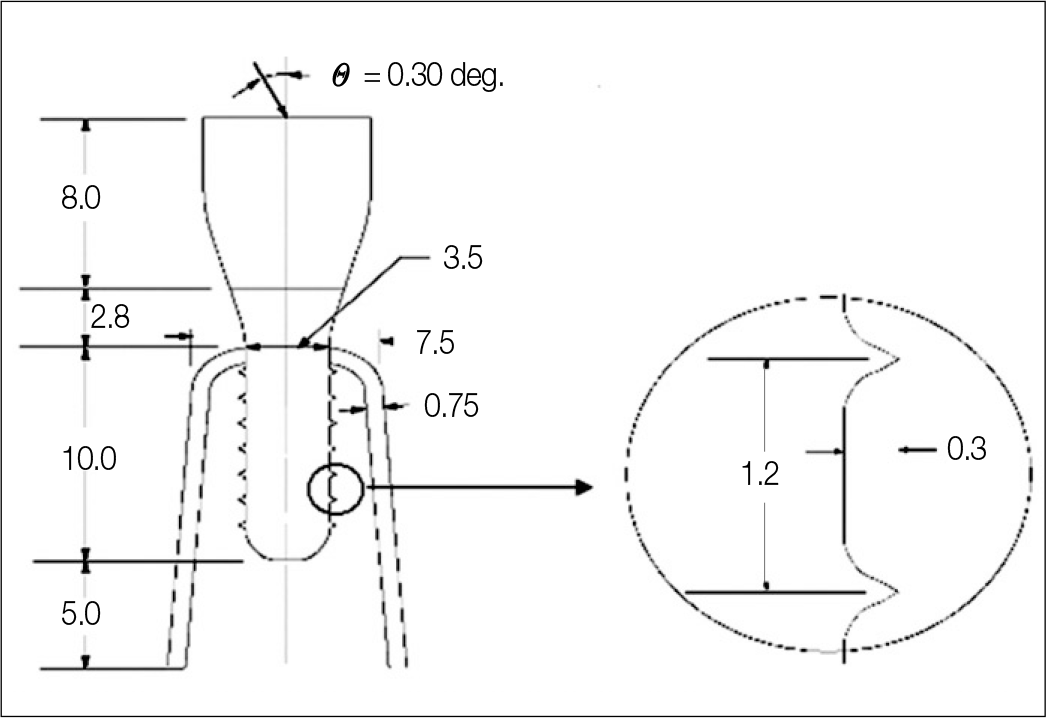 | Fig. 1.Basic geometry model (control model: ITI implant system) showing important dimensions of the implant/bone complex used in this study. The view within the right hand side circle shows a thread design of the ITI implant system (unit: mm). |
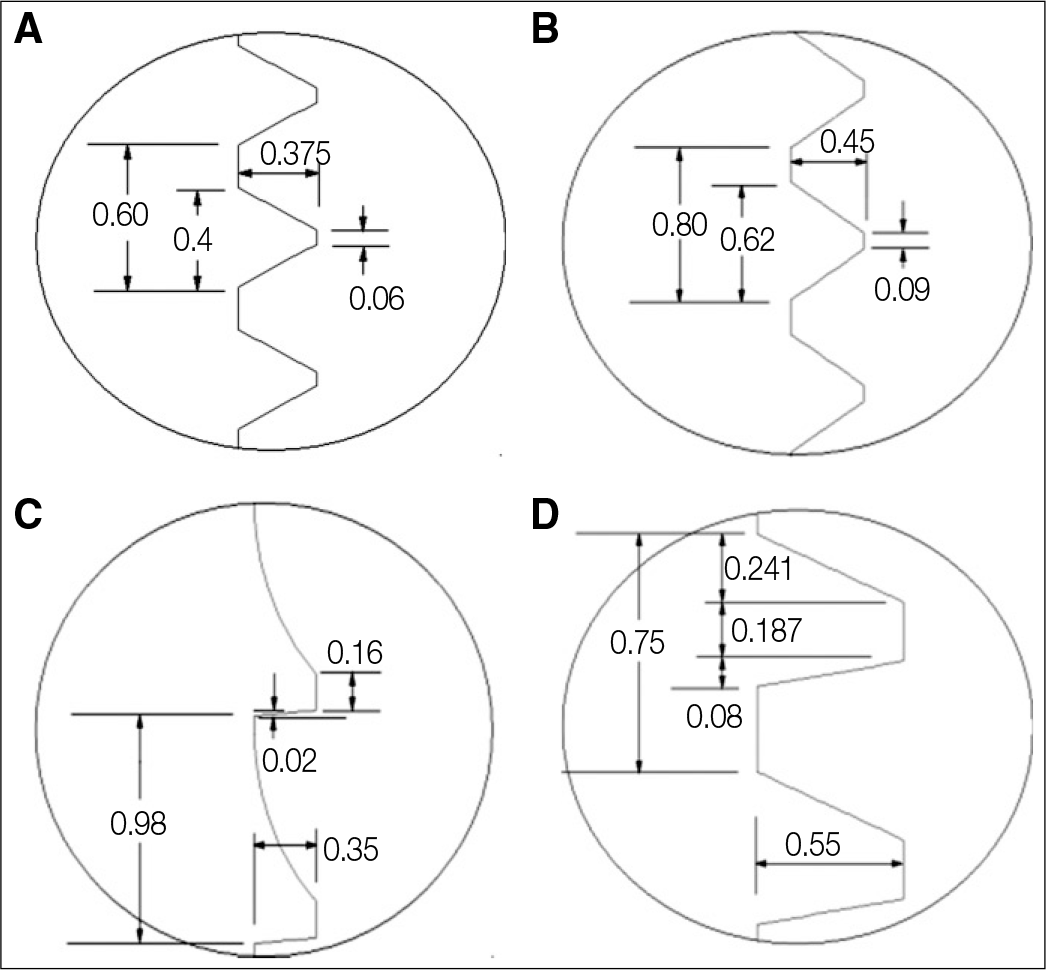 | Fig. 2.The 4 test implants with different screw designs. (A) small V-shape screw, (B) large V-shape screw, (C) buttress screw, and (D) trapezoid screw (unit: mm). |
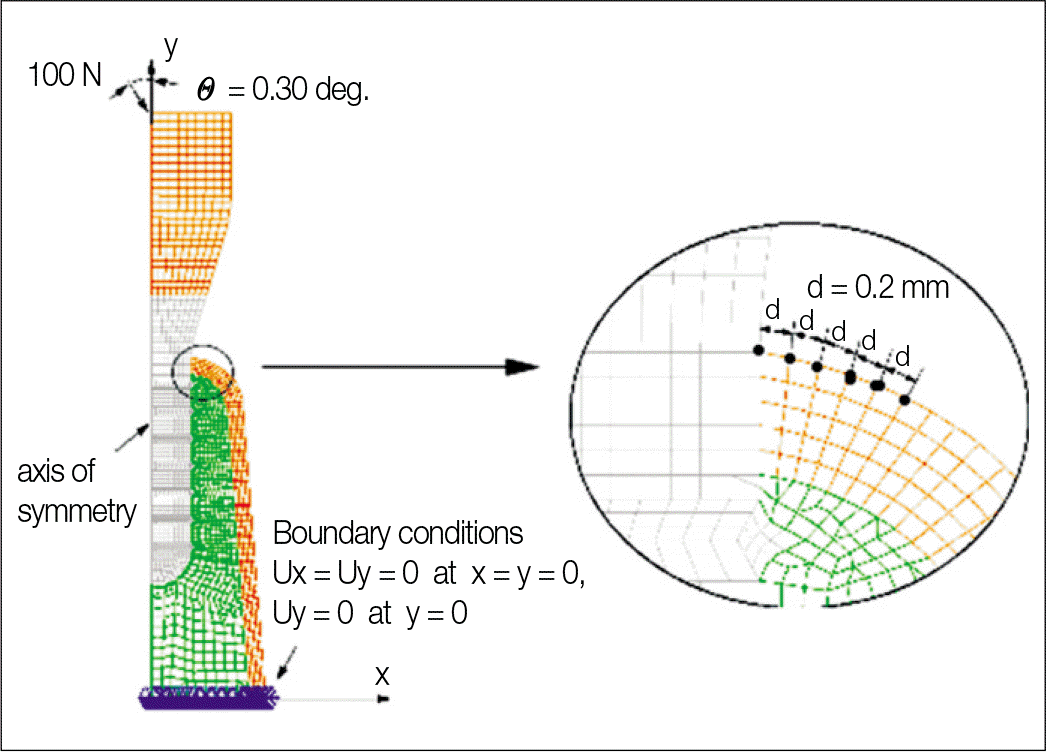 | Fig. 3.Typical finite element mesh used for control model. A view within circle presented in the right hand side shows the five stress monitoring points on the surface of marginal bone 0.2 mm apart each others. |
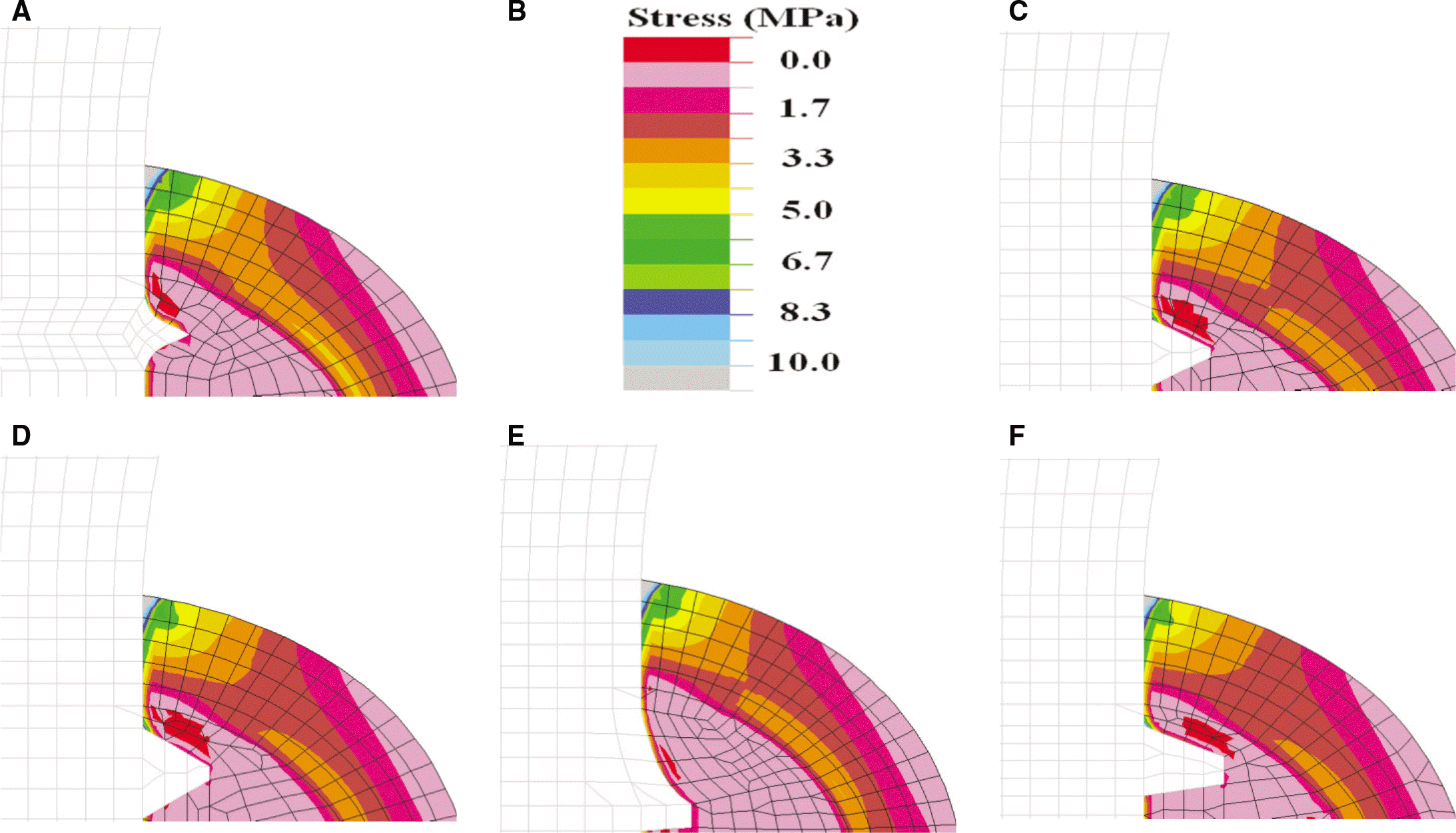 | Fig. 4.Stress distributions (maximum compressive stress) in the marginal bone around the 5 implant models subject to a vertical load of 100 N. (A) control model (ITI implant), (B) stress band, and implants with (C) small V-shape, (D) large V-shape, (E) buttress, and (F) trapezoid screws. |
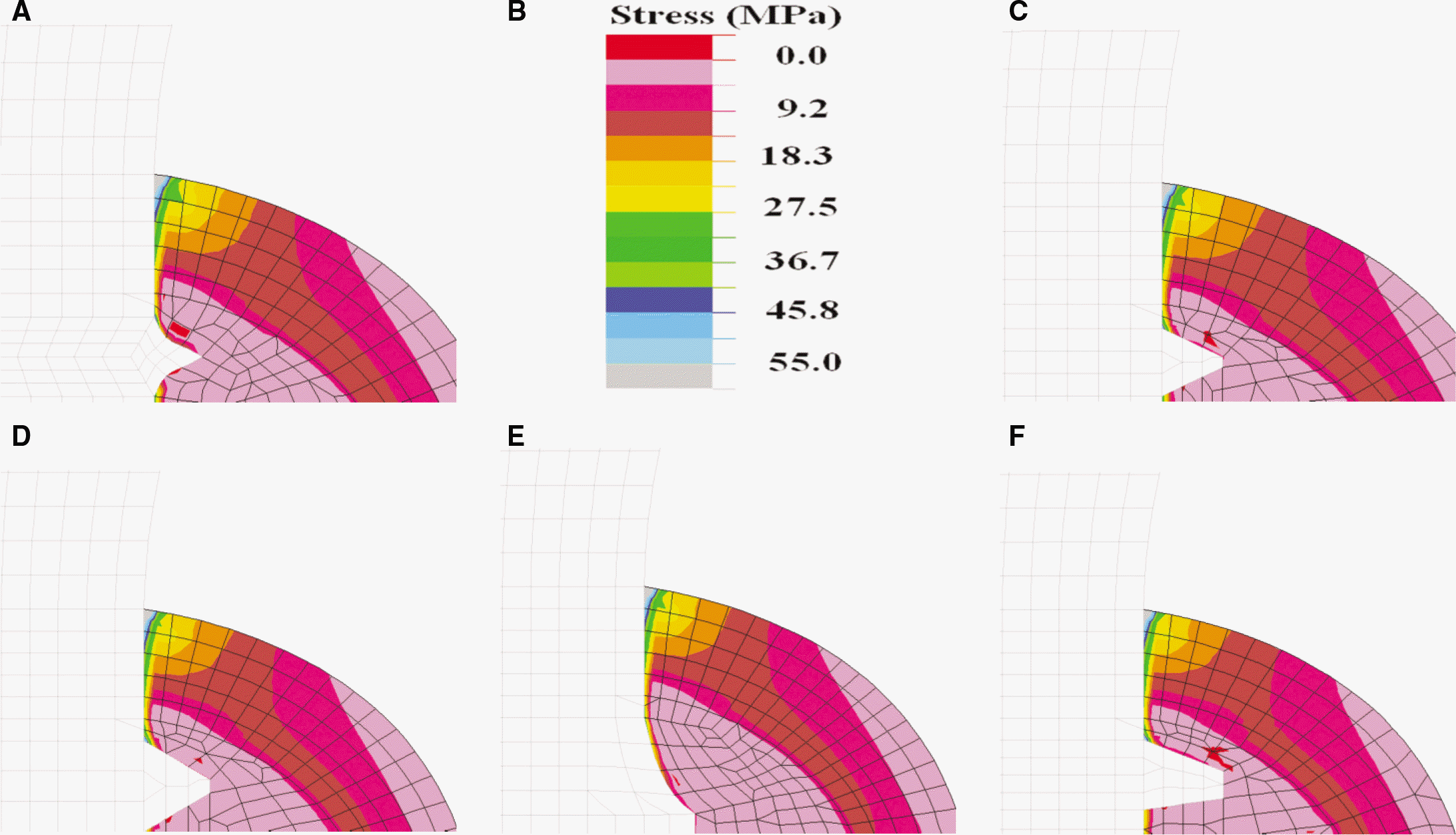 | Fig. 5.Stress distributions (maximum compressive stress) in the marginal bone around the 5 implant models subject to an oblique load of 100 N. (A) control model (ITI implant), (B) stress band, and implants with (C) small V-shape, (D) large V-shape, (E) buttress, and (F) trapezoid screws. |
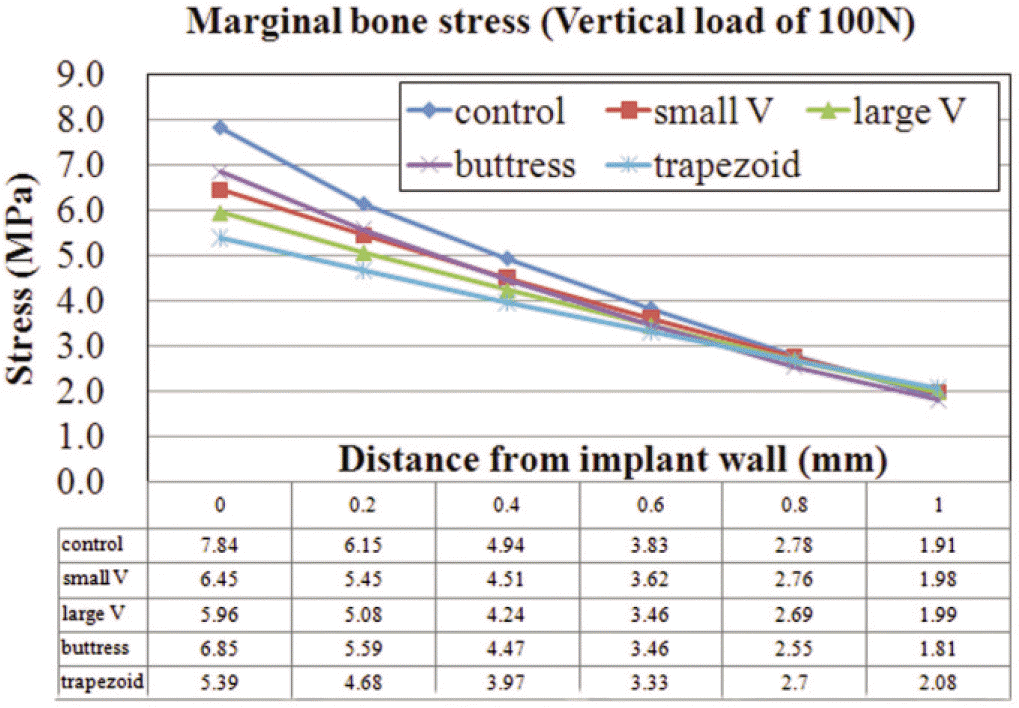 | Fig. 6.Stress distribution on the external surface of marginal bone around the 5 implant models subject to a vertical load of 100 N. |
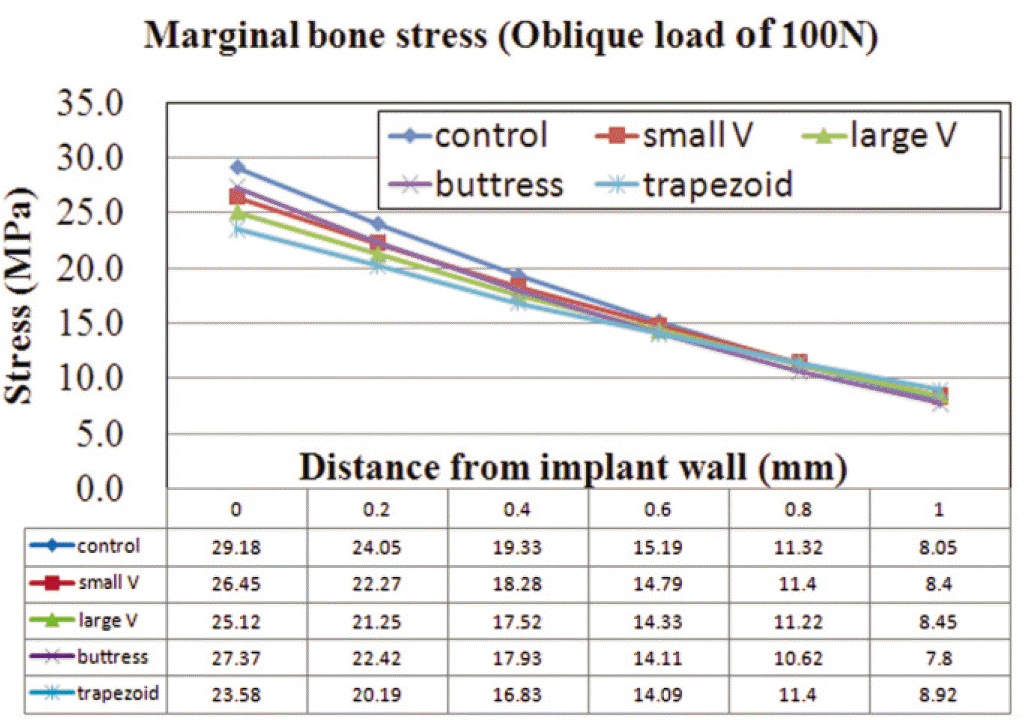 | Fig. 7.Stress distribution on the external surface of marginal bone around the 5 implant models subject to an oblique load of 100 N. |
Table 1.
Mechanical properties (bone and implant materials)




 PDF
PDF ePub
ePub Citation
Citation Print
Print


 XML Download
XML Download